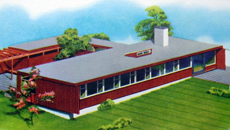The Future of the Canadian House in ...1954
by Izabel Amaral
, published 2007-03-01

With circumspection and little nostalgia, the CCC presents the laureate projects for the 1954 competition entitled: "International Calvert House Competition for the Canadian Home of Tomorrow." 1600 registrants and an astounding 661 submission from 17 countries made this a major event in Canadian architecture circles in the 1950s. Where are we now in terms of these interesting predictions of house and home?
Being free of nostalgia, while having an eye towards circumspection, the CCC presents the laureate projects for 1954's "International Calvert House Competition for the Canadian Home of Tomorrow." As a major event in Canadian architecture circles in the 1950s, this competition saw 1600 registrants and obtained 661 proposals from 17 countries. Over fifty years later we ask: How have we faired with respect to the vision of house and home that was projected in this post-war era?
Canada in the 1950s was privy to a number of important competitions for public buildings : The National Gallery in Ottawa (1953), The Civic Auditorium in Vancouver (1956), and Toronto City Hall (1958). These prominent buildings were a symbol of civic power and are still influential in their respective urban environments. The same cannot be said of the projects proposed in the Calvert House competition, whose domestic influence has been limited and as such, have not been a factor in shaping the history of Canadian architecture. What to think of this missed opportunity for architects to shape 'domestic desires' back in the 50s, when the form and style of our homes is still such a hot topic for debate in this new millennium? At the time, the Calvert homes were published in a catalogue available for sale, in a concerted effort to make them accessible at large. Consequently, it is of interest to reconstitute the journey of a certain number of these homes in an effort to better comprehend the outcome of this unusual and large-scale meeting of architecture and the domestic environment.
After World War Two, housing in Canada was a top priority. The projects selected in the 1954 Calvert House competition mark the entry of certain modernist architectural values into the domestic realm. With its manifestation of technical and aesthetic innovations, the Calvert House entries were a far cry from the CMHC housing competition of 1946. A quick look at the CCC documentation of both of these competitions reveals a dramatic change from one to the next. The traditional homes with decorated façades presented in 1946, make way, in 1954, for typically modernist attributes such as flat roofs, continuity of space, ribbon windows, pergolas, abstract compositions, and asymmetry. Should this emulation of the international mind-set be attributed to the favourable reputation of Calvert House's jury members? (Professors John Bland and Pierre Morency as professional advisors and Italian architect Gio Ponti as jury president.) It is interesting to note that Leap researchers have determined through comparative research methods, that most times, a good competition is highly dependant on the calibre of its jury.
Being free of nostalgia, while having an eye towards circumspection, the CCC presents the laureate projects for 1954's "International Calvert House Competition for the Canadian Home of Tomorrow." As a major event in Canadian architecture circles in the 1950s, this competition saw 1600 registrants and obtained 661 proposals from 17 countries. Over fifty years later we ask: How have we faired with respect to the vision of house and home that was projected in this post-war era?
Canada in the 1950s was privy to a number of important competitions for public buildings : The National Gallery in Ottawa (1953), The Civic Auditorium in Vancouver (1956), and Toronto City Hall (1958). These prominent buildings were a symbol of civic power and are still influential in their respective urban environments. The same cannot be said of the projects proposed in the Calvert House competition, whose domestic influence has been limited and as such, have not been a factor in shaping the history of Canadian architecture. What to think of this missed opportunity for architects to shape 'domestic desires' back in the 50s, when the form and style of our homes is still such a hot topic for debate in this new millennium? At the time, the Calvert homes were published in a catalogue available for sale, in a concerted effort to make them accessible at large. Consequently, it is of interest to reconstitute the journey of a certain number of these homes in an effort to better comprehend the outcome of this unusual and large-scale meeting of architecture and the domestic environment.
After World War Two, housing in Canada was a top priority. The projects selected in the 1954 Calvert House competition mark the entry of certain modernist architectural values into the domestic realm. With its manifestation of technical and aesthetic innovations, the Calvert House entries were a far cry from the CMHC housing competition of 1946. A quick look at the CCC documentation of both of these competitions reveals a dramatic change from one to the next. The traditional homes with decorated façades presented in 1946, make way, in 1954, for typically modernist attributes such as flat roofs, continuity of space, ribbon windows, pergolas, abstract compositions, and asymmetry. Should this emulation of the international mind-set be attributed to the favourable reputation of Calvert House's jury members? (Professors John Bland and Pierre Morency as professional advisors and Italian architect Gio Ponti as jury president.) It is interesting to note that Leap researchers have determined through comparative research methods, that most times, a good competition is highly dependant on the calibre of its jury.













